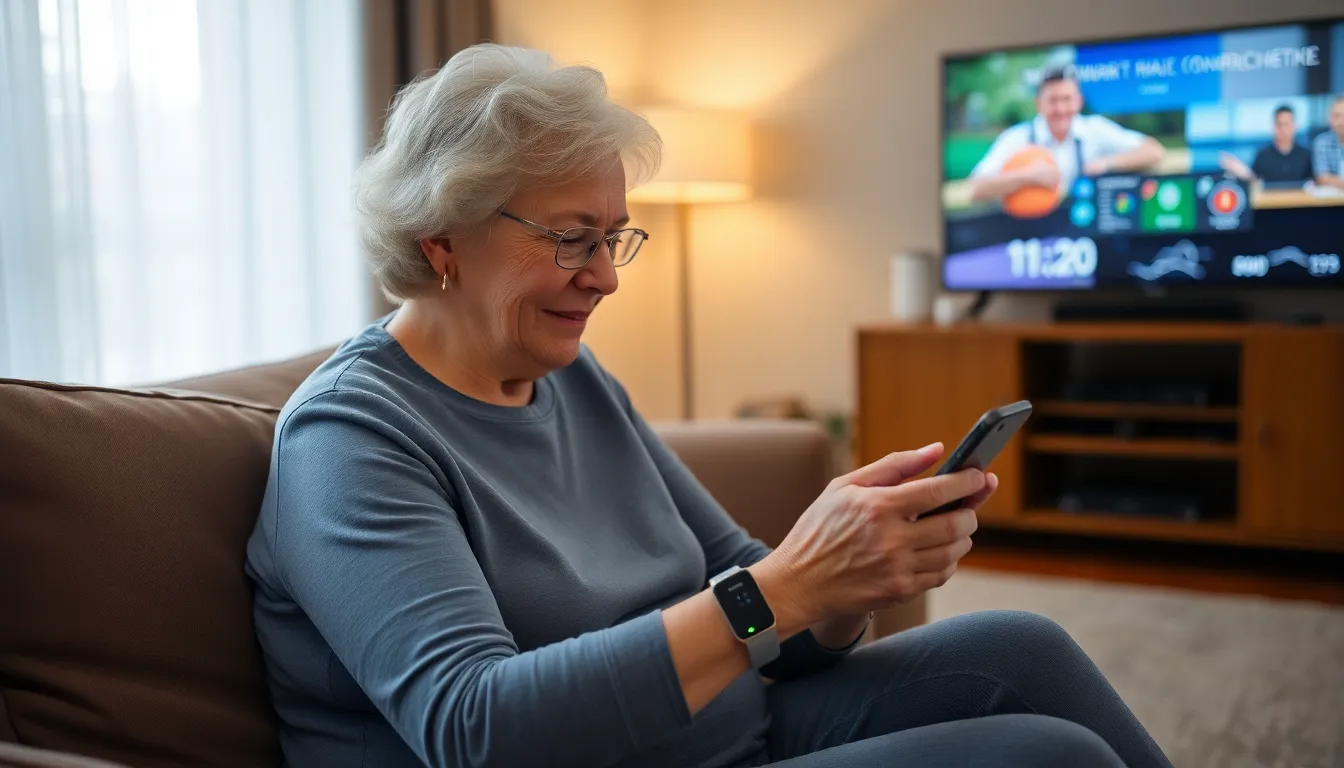Imagine a world where grandma’s morning coffee brews itself while her favorite show starts playing just as she settles into her comfy chair. With the Internet of Things (IoT) for seniors, this isn’t just a fantasy—it’s a reality waiting to happen. As technology leaps forward, it’s not just the younger crowd who gets to enjoy the perks. Seniors can embrace this smart lifestyle too, and it’s about time!
Table of Contents
ToggleOverview of IoT for Seniors
IoT technology significantly transforms seniors’ lives by making daily tasks simpler and more efficient. Devices such as smart home assistants allow voice commands for controlling lights, appliances, and temperatures. Seniors can also receive medication reminders through connected apps, ensuring they stay on schedule.
Smart wearables, including health monitors, track vital signs like heart rate and activity levels. These devices provide valuable insights, allowing seniors to share health data with caregivers in real-time. Security systems equipped with cameras and motion sensors enhance home safety, giving seniors peace of mind.
Connectivity through IoT fosters social interaction, as video conferencing tools enable seniors to remain engaged with family and friends. Smart TVs offer easy access to streaming services, catering to diverse entertainment preferences. In addition, automated home appliances make chores like cooking and cleaning less burdensome.
Research shows that engaging with IoT can improve cognitive functions among seniors by encouraging problem-solving and adaptation skills. Financially, IoT can save money by optimizing energy usage through smart thermostats and lighting systems.
As technology rapidly evolves, many companies focus on creating senior-friendly products. This includes simplified interfaces and voice-activated controls that cater to users with varying tech-savviness. The rise of IoT presents seniors with opportunities to enhance independence, manage health, and maintain social connections effectively.
Benefits of IoT for Seniors

IoT technology provides numerous benefits for seniors, enhancing their quality of life. From improved safety to better health management, these devices make daily tasks manageable and enjoyable.
Enhanced Safety and Security
Smart home security systems offer peace of mind through features like motion sensors and security cameras. These devices send alerts to seniors’ smartphones, notifying them of any unusual activities. Smart doorbells allow for two-way communication, helping seniors to screen visitors before opening the door. Furthermore, fall detection systems can automatically alert caregivers or emergency services if someone falls, ensuring timely help. Enhanced lighting systems can also adjust automatically to improve visibility at night, decreasing the risk of accidents.
Health Monitoring
Wearable devices play a crucial role in monitoring seniors’ health, tracking vital signs like heart rate and blood pressure. These wearables communicate real-time data to healthcare providers, promoting proactive health management. Applications provide medication reminders, reducing the likelihood of missed doses. Telehealth services facilitate virtual appointments, allowing seniors to consult with doctors without travel. Regular monitoring through IoT devices can lead to earlier detection of health issues, improving treatment outcomes significantly.
Improved Daily Living
Smart appliances simplify daily chores for seniors, making life easier and more enjoyable. Voice command technology enables seniors to control devices hands-free, from adjusting thermostats to brewing coffee. Automatic vacuum systems can help maintain cleanliness with minimal effort. Additionally, smart TVs provide easy access to shows or movies, catering to entertainment preferences effortlessly. These advancements lead to increased leisure time, ultimately enhancing overall well-being and independence for seniors.
Challenges Facing IoT for Seniors
Seniors encounter specific challenges in adopting Internet of Things (IoT) technology. Addressing these obstacles is crucial for improving their experience and ensuring they benefit fully from smart solutions.
Technology Adoption Barriers
Many seniors face technology adoption barriers. Older adults often struggle with navigating complex interfaces. Training programs can help familiarize them with smart devices. Ease of use matters when introducing new devices to this demographic. Companies must prioritize user-friendly designs to attract seniors. Awareness campaigns that highlight the benefits of IoT also support increased acceptance and engagement. Fear of technology can hinder adoption; thus, hands-on assistance from family members or caregivers proves essential in overcoming these barriers.
Privacy Concerns
Privacy concerns present significant challenges for seniors regarding IoT. Data security is vital as many devices collect personal information. Seniors might worry about unauthorized access to their personal data. Simple measures, such as using strong passwords and regularly updating software, increase security. Educating seniors about protecting their privacy can build trust in technology. Transparency from manufacturers about how data is used also alleviates concerns. Ultimately, addressing privacy issues enables seniors to utilize IoT solutions confidently and securely.
Future Trends in IoT for Seniors
Emerging trends in IoT promise to reshape the experiences of seniors significantly. Increased integration of artificial intelligence in smart devices facilitates personalized interactions and automates daily tasks. Companies are focusing on developing devices that respond to individual preferences, enhancing user experience for older adults.
Voice-activated technologies continue to evolve, providing hands-free control over home environments. Simplified user interfaces will become standard, making navigation easier for seniors. Research by the AARP indicates that user-friendly designs minimize frustration, encouraging adoption among older adults.
Healthcare solutions are also advancing through IoT. Wearable devices will not only track vital signs but also utilize real-time data analytics to predict health issues before they arise. Telehealth consultations are gaining traction, offering seniors immediate access to healthcare professionals without travel.
Security features are benefitting from innovations as well. Smart home systems are incorporating more advanced monitoring capabilities, such as AI-driven alerts for unusual activity. This added layer of security enhances safety and peace of mind for both seniors and their families.
Social connections stand to improve through enhanced communication tools. IoT devices designed for video calls are integrating more seamlessly into daily routines, making it easier for seniors to engage with loved ones. This connection helps combat feelings of isolation, promoting mental well-being.
Financial implications are also noteworthy. Smart home technologies can lead to significant energy savings through automation and efficient resource management. By adopting these devices, seniors may enjoy reduced utility bills, adding financial relief to their daily lives.
Lastly, community initiatives focusing on educating seniors about IoT benefits will expand. Local programs that offer hands-on training help older adults become comfortable with technology. Accessibility frameworks will play a crucial role in ensuring all seniors can participate in this tech-forward future.
Embracing IoT technology can significantly enhance the quality of life for seniors. With smart devices simplifying daily tasks and improving health management, older adults can enjoy greater independence and safety. The potential for increased social interaction and connection through technology further enriches their lives.
As companies continue to innovate and prioritize user-friendly designs, seniors will have more opportunities to engage with these advancements. By addressing challenges such as privacy concerns and complex interfaces, the path to a tech-savvy lifestyle becomes clearer. Ultimately, the integration of IoT into seniors’ lives represents a promising future filled with convenience, security, and enhanced well-being.





